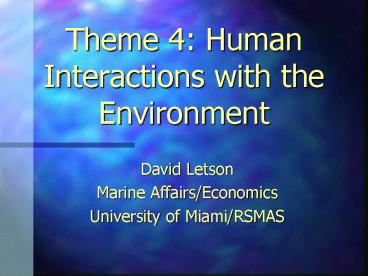Theme 4: Human Interactions with the Environment - PowerPoint PPT Presentation
1 / 19
Title:
Theme 4: Human Interactions with the Environment
Description:
Theme 4: Human Interactions with the Environment David Letson Marine Affairs/Economics University of Miami/RSMAS – PowerPoint PPT presentation
Number of Views:119
Avg rating:3.0/5.0
Title: Theme 4: Human Interactions with the Environment
1
Theme 4 Human Interactions with the Environment
- David Letson
- Marine Affairs/Economics
- University of Miami/RSMAS
2
Roadmap
- I. Statement of Theme 4. Humans shape are
shaped by natural systems. - II. Important contributions to several NOAA
related interdisciplinary projects. - Use of climate information.
- Conceptual models of NERR sites.
- Marine reserve design.
- III. Vision for the future.
3
Part I Humans as Part of System
- Inter-dependence of humans and ecosystems
- Role of human systems in environmental decisions.
- Two foci
- Human dimensions of climatic change and
variability - Sustainable use of the worlds fisheries.
- No outside influence. Essential systemic
component.
4
Our Approach Integrated Assessment
- Synthesis and critical appraisal of scientific
information on a topic. - Advancing state of knowledge ensuring its
relevance. - Multiple disciplines institutions. Local
knowledge. - Not just the analytical products but also the
dialogue that produced them.
5
Part II A Few Projects
- (A) Use of climate information
- (B) Conceptual models of NERR sites
- (C) Marine reserve design.
6
(A) Use of Climate Information
Precipitation
- ENSO affects Regional Climate
- Lower (higher) temps in El Niño (Niña).
- Higher (lower) precip in El Niño (Niña).
- ENSO affects Tomatoes
- Winter yields decrease during El Niño.
- NOAA/OGP USDA/RMA funds.
- UM, FSU, UGA, UF, Auburn UA-Huntsville.
Temperature
Tomato yields
Relative Yields
Source James Hansen et al. Journal of Climate
1999
7
- Bridging gap between climate forecasters and
users - learn user needs for and perceptions of climate
forecasts - evaluate usefulness and limitations of climate
forecasts - translate forecasts into decision support for
agriculture water - demonstrate successful forecast applications
8
(B) Conceptual Models Estuaries as Integrated
Systems
- Natural systems rates of soil and water
movement. - Socioeconomic factors size and distribution of
costs and benefits. - Interplay of natural and human systems creates
problems, opportunities. - NOAAS Educational Partnership Program for
Minority Serving Institutions UM, FAMU, Morgan
State, Jackson State, Delaware State, South
Carolina State
9
Integrated Watershed Analysis Management
- Five NERR sites in SC, FL, MD, MS DE
- Social scientists assess societal goals and
policy options through a process of inclusion and
consultation. - Can only be as good as cooperating social and
natural science efforts. - We depend on natural scientists to assess changes
in the natural world that may affect human well
being.
10
(C) Marine Reserves
- (1) Broad/Olson NSF biocomplexity project in the
Bahamas. - (2) Die/Letson/Shivlani MARFIN recreational
diving survey to evaluate benefits of reserves.
11
(1) Marine Reserve Design
- Optimal placement of Bahamian MPA network.
- National Science Foundation/Biocomplexity
project. - Integrating socioeconomics, biology physics.
- Connectivity attitudes, uses, resource
conditions. - UM (K. Broad D. Olson), American Museum of
Natural History, Stanford, Resources for the
Future.
12
(2) Recreational Diving and Marine Reserves
- Diver preference survey
- Questionnaire developed in conjunction with
students Kristin Kleisner and Katie Drew - Administered by cooperating dive shops
- Die/Letson/Shivlani with MARFIN support
- Goals
- Willingness-to-pay for marine reserves in FKNMS
- Rank attributes that enhance diver satisfaction
- Evaluate diver preference for marine reserves
13
Part III Vision of the Future
- Climate services.
- Sustainable fisheries.
- We can help each other a great deal.
14
Climate Services
- A process including
- Several components
- Not only climate forecasts
- Continuous evaluation and incorporation of
feedback
Adapted from Sarewitz, Pielke and Byerly 2000.
Prediction. Island Press. Page 376.
15
Sustainable Fisheries
- Biologically healthy fish stocks.
- Economically healthy fishing businesses.
- Maintaining social productivity
- Fishing cultures and communities
- Diversity in scales of fishing operations
- Opportunities for recreational subsistence
fishing. - How should we measure success?
16
In Conclusion
- Goals determined by societal preferences, by
design or default. - Humans are not an outside influence but an
essential systemic component. - Toward a shared vision of sustainable use.
17
Climate Information Water Resources Planning
- Analysis of the decision-making process
- constraints to forecast use
- user needs
- organizational decision rules and process
- Decision support tools
- existing procedures, models and management tools
- refinements to incorporate climate information
18
Probability of Hurricane Strikes
19
Other Potential Uses of Climate Forecasts































